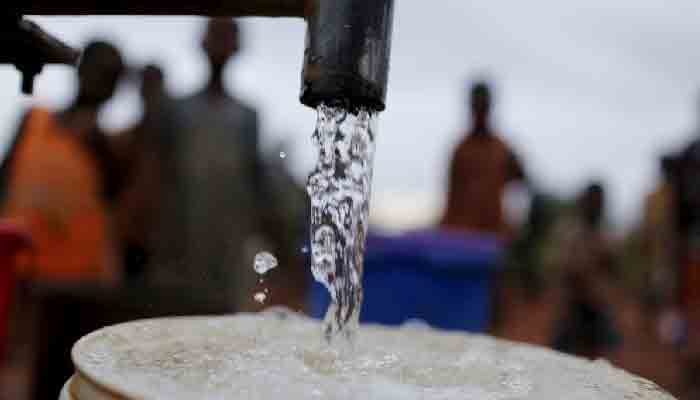People in 29 major cities, including Karachi, drinking contaminated water
In Karachi, 93% of drinking water is contaminated which is full of turbidity, hardness, chloride, fluoride and bacteria, according to official findings
August 24, 2021

- 100% drinking water quality of two districts of Sindh is unsafe, according to official figures.
- Contaminated water is putting the lives of people at risk.
- 94% of drinking water is unsafe in Multan city, which falls in the constituency of Foreign Minister Shah Mehmood Qureshi.
ISLAMABAD: Millions of people in 29 major cities, including Karachi, are drinking contaminated water which is putting their lives at risk, said the latest research on underground water.
According to the findings of the Pakistan Council of Research in Water Resources (PCRWR), the quality of drinking water in 29 major cities is dangerously unsafe.
"Overall, 62% of the drinking water quality of these [29] major cities is unsafe. Underground water of these cities is full of turbidity, hardness, chloride, TDS, bacteriological and other chemicals," reads the research, which was presented before the parliament earlier this month.
100% drinking water quality of two districts of Sindh is unsafe, according to official figures. These districts included Mirpurkhas and Shaheed Benazirabad. The district of Gilgit-Baltistan also has 100% unsafe drinking water, which is full of turbidity, hardness, chloride, TDS and bacteriological or denoting germ warfare.
"Long-term consumption of arsenic beyond the safe level may result in various health implications -- symptoms of long-term exposure to high levels of inorganic arsenic which ultimately is developing skin cancer," read the report.
The water quality monitoring (2020-21) of other 28 cities of the country has revealed the prevalence of bacteriological contamination (39%) followed by arsenic (8%), nitrate (4%), fluoride (4%), etc, according to official documents. The water quality monitoring of District Dadu, undertaken by PCRWR (2017-18), revealed that 91(89%) of the 112 monitored water sources were unsafe for drinking purposes mainly due to bacterial contamination.
In Karachi, some 93% of drinking water is contaminated which is full of turbidity, hardness, chloride, TDS, fluoride and bacteria, according to official findings.
94% of drinking water is unsafe in Multan city, which falls in the constituency of Foreign Minister Shah Mehmood Qureshi. 92% water is unsafe in Badin, 83% in Sargodha and 80% water is polluted with hardness, chloride, fluoride, TDS, Iron and NO2 and bacteria in Hyderabad, read the documents.
The alarming rise in contaminated water came after the PCRWR noted 57% samples of water were contaminated in major cities of Pakistan in 2015-16. The drinking water quality situation in Sindh and Balochistan has even gone down while the council established 24 water quality laboratories in the country.
Official figures continued to reveal that 76% underground water is contaminated in Bahawalpur, 70% in Muzaffarabad, 67% in Sukkur, 63 in Quetta, 59% in Faisalabad, 58% in Peshawar, 57% in Tando Allahyar, 55% in Khuzdar, Abbottabad and Sheikhupura, 54% in Loralai, 50% Gujranwala, 45% in Mardan, 38% in Rawalpindi and Islamabad, 31% in Lahore, 20% Mingora and 10% water is contaminated in Kasur, read the official figures.
The PCRWR took 433 samples where 267 (62%) samples were found contaminated. As many as 166 (38%) samples were found satisfactory. Over 88 (85%) of the total 103 samples were found contaminated in seven cities of Sindh.
Some 42 (58%) of the total 73 samples of water were found unsafe in four districts of Balochistan. Some 20 (45%) of the total 44 samples were found unsafe in four districts of KPK. Some 100 (52%) of the total 193 samples were contaminated in 11 districts of Punjab. Some nine (38%) of the total 24 samples were found contaminated in the federal capital.
The PCRWR, following the JWC, undertook the water quality assessment of different water sources in the province which in its findings proved that some of provincial cities like Karachi housed 76% contaminated water full of arsenic (sankhia) 28%, iron (36%), fluoride and other bacteria.
The Pakistan Standard & Quality Control Authority found 200 of total 1,140 brands of beverages and bottled drinking water substandard in 2018, according to official figures.
Geo News approached Chairman PCRWR Dr Mohammad Ashraf repeatedly to know his view on this deteriorating water quality situation in major cities and steps being taken by the federal government. No response was received from the PCRWR till the filing of the story.
Originally published in The News











